Wenbin Li
Department of Computing, Imperial College London, London UK, SW7 2AZ
Branch, or Layer? Zeroth-Order Optimization for Continual Learning of Vision-Language Models
Jun 14, 2025Abstract:Continual learning in vision-language models (VLMs) faces critical challenges in balancing parameter efficiency, memory consumption, and optimization stability. While First-Order (FO) optimization (e.g., SGD) dominate current approaches, their deterministic gradients often trap models in suboptimal local minima and incur substantial memory overhead. This paper pioneers a systematic exploration of Zeroth-Order (ZO) optimization for vision-language continual learning (VLCL). We first identify the incompatibility of naive full-ZO adoption in VLCL due to modality-specific instability. To resolve this, we selectively applying ZO to either vision or language modalities while retaining FO in the complementary branch. Furthermore, we develop a layer-wise optimization paradigm that interleaves ZO and FO across network layers, capitalizing on the heterogeneous learning dynamics of shallow versus deep representations. A key theoretical insight reveals that ZO perturbations in vision branches exhibit higher variance than language counterparts, prompting a gradient sign normalization mechanism with modality-specific perturbation constraints. Extensive experiments on four benchmarks demonstrate that our method achieves state-of-the-art performance, reducing memory consumption by 89.1% compared to baselines. Code will be available upon publication.
Adapting In-Domain Few-Shot Segmentation to New Domains without Retraining
Apr 30, 2025Abstract:Cross-domain few-shot segmentation (CD-FSS) aims to segment objects of novel classes in new domains, which is often challenging due to the diverse characteristics of target domains and the limited availability of support data. Most CD-FSS methods redesign and retrain in-domain FSS models using various domain-generalization techniques, which are effective but costly to train. To address these issues, we propose adapting informative model structures of the well-trained FSS model for target domains by learning domain characteristics from few-shot labeled support samples during inference, thereby eliminating the need for retraining. Specifically, we first adaptively identify domain-specific model structures by measuring parameter importance using a novel structure Fisher score in a data-dependent manner. Then, we progressively train the selected informative model structures with hierarchically constructed training samples, progressing from fewer to more support shots. The resulting Informative Structure Adaptation (ISA) method effectively addresses domain shifts and equips existing well-trained in-domain FSS models with flexible adaptation capabilities for new domains, eliminating the need to redesign or retrain CD-FSS models on base data. Extensive experiments validate the effectiveness of our method, demonstrating superior performance across multiple CD-FSS benchmarks.
Robust Dataset Distillation by Matching Adversarial Trajectories
Mar 15, 2025Abstract:Dataset distillation synthesizes compact datasets that enable models to achieve performance comparable to training on the original large-scale datasets. However, existing distillation methods overlook the robustness of the model, resulting in models that are vulnerable to adversarial attacks when trained on distilled data. To address this limitation, we introduce the task of ``robust dataset distillation", a novel paradigm that embeds adversarial robustness into the synthetic datasets during the distillation process. We propose Matching Adversarial Trajectories (MAT), a method that integrates adversarial training into trajectory-based dataset distillation. MAT incorporates adversarial samples during trajectory generation to obtain robust training trajectories, which are then used to guide the distillation process. As experimentally demonstrated, even through natural training on our distilled dataset, models can achieve enhanced adversarial robustness while maintaining competitive accuracy compared to existing distillation methods. Our work highlights robust dataset distillation as a new and important research direction and provides a strong baseline for future research to bridge the gap between efficient training and adversarial robustness.
WeakMedSAM: Weakly-Supervised Medical Image Segmentation via SAM with Sub-Class Exploration and Prompt Affinity Mining
Mar 06, 2025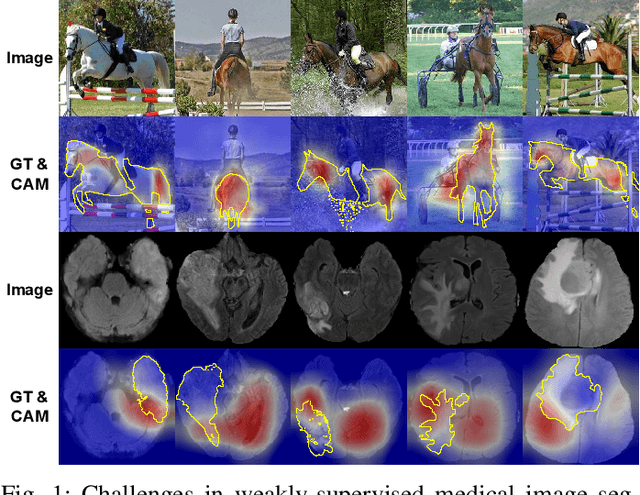
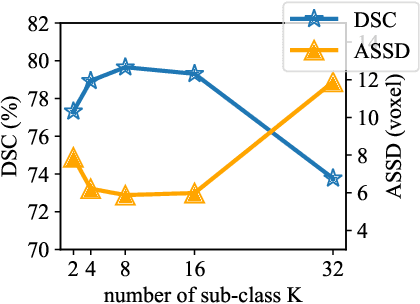
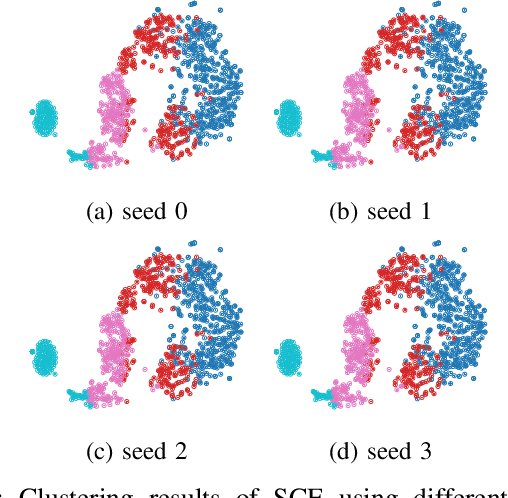
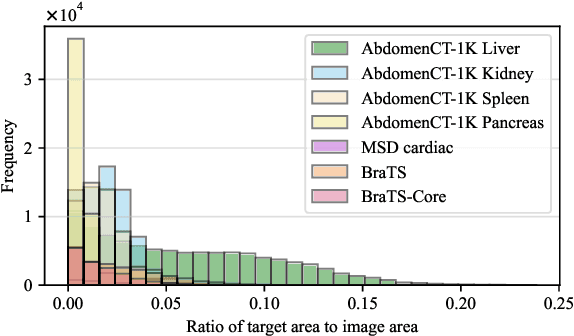
Abstract:We have witnessed remarkable progress in foundation models in vision tasks. Currently, several recent works have utilized the segmenting anything model (SAM) to boost the segmentation performance in medical images, where most of them focus on training an adaptor for fine-tuning a large amount of pixel-wise annotated medical images following a fully supervised manner. In this paper, to reduce the labeling cost, we investigate a novel weakly-supervised SAM-based segmentation model, namely WeakMedSAM. Specifically, our proposed WeakMedSAM contains two modules: 1) to mitigate severe co-occurrence in medical images, a sub-class exploration module is introduced to learn accurate feature representations. 2) to improve the quality of the class activation maps, our prompt affinity mining module utilizes the prompt capability of SAM to obtain an affinity map for random-walk refinement. Our method can be applied to any SAM-like backbone, and we conduct experiments with SAMUS and EfficientSAM. The experimental results on three popularly-used benchmark datasets, i.e., BraTS 2019, AbdomenCT-1K, and MSD Cardiac dataset, show the promising results of our proposed WeakMedSAM. Our code is available at https://github.com/wanghr64/WeakMedSAM.
CausalTAD: Causal Implicit Generative Model for Debiased Online Trajectory Anomaly Detection
Dec 25, 2024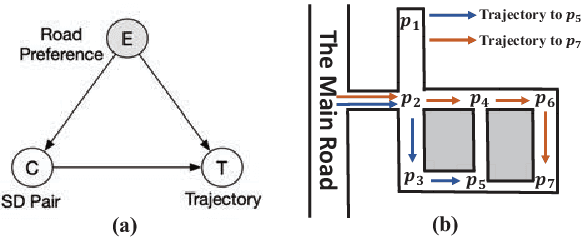
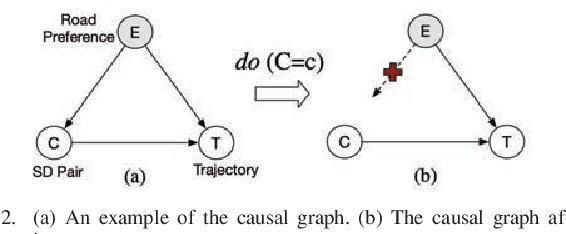
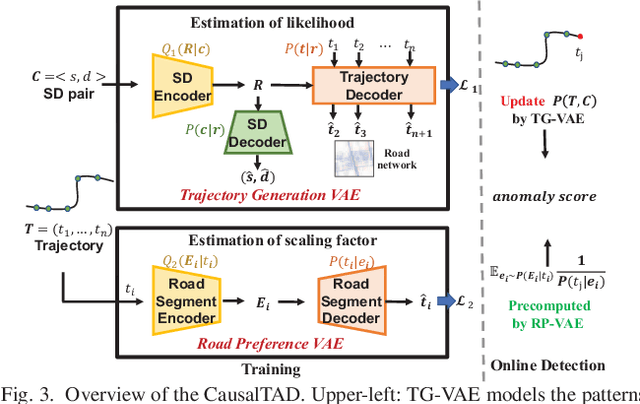
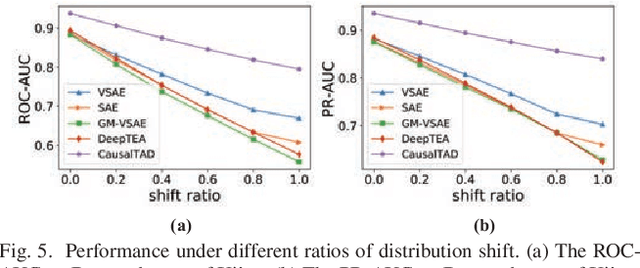
Abstract:Trajectory anomaly detection, aiming to estimate the anomaly risk of trajectories given the Source-Destination (SD) pairs, has become a critical problem for many real-world applications. Existing solutions directly train a generative model for observed trajectories and calculate the conditional generative probability $P({T}|{C})$ as the anomaly risk, where ${T}$ and ${C}$ represent the trajectory and SD pair respectively. However, we argue that the observed trajectories are confounded by road network preference which is a common cause of both SD distribution and trajectories. Existing methods ignore this issue limiting their generalization ability on out-of-distribution trajectories. In this paper, we define the debiased trajectory anomaly detection problem and propose a causal implicit generative model, namely CausalTAD, to solve it. CausalTAD adopts do-calculus to eliminate the confounding bias of road network preference and estimates $P({T}|do({C}))$ as the anomaly criterion. Extensive experiments show that CausalTAD can not only achieve superior performance on trained trajectories but also generally improve the performance of out-of-distribution data, with improvements of $2.1\% \sim 5.7\%$ and $10.6\% \sim 32.7\%$ respectively.
Effective and Efficient Representation Learning for Flight Trajectories
Dec 21, 2024



Abstract:Flight trajectory data plays a vital role in the traffic management community, especially for downstream tasks such as trajectory prediction, flight recognition, and anomaly detection. Existing works often utilize handcrafted features and design models for different tasks individually, which heavily rely on domain expertise and are hard to extend. We argue that different flight analysis tasks share the same useful features of the trajectory. Jointly learning a unified representation for flight trajectories could be beneficial for improving the performance of various tasks. However, flight trajectory representation learning (TRL) faces two primary challenges, \ie unbalanced behavior density and 3D spatial continuity, which disable recent general TRL methods. In this paper, we propose Flight2Vec , a flight-specific representation learning method to address these challenges. Specifically, a behavior-adaptive patching mechanism is used to inspire the learned representation to pay more attention to behavior-dense segments. Moreover, we introduce a motion trend learning technique that guides the model to memorize not only the precise locations, but also the motion trend to generate better representations. Extensive experimental results demonstrate that Flight2Vec significantly improves performance in downstream tasks such as flight trajectory prediction, flight recognition, and anomaly detection.
Text and Image Are Mutually Beneficial: Enhancing Training-Free Few-Shot Classification with CLIP
Dec 16, 2024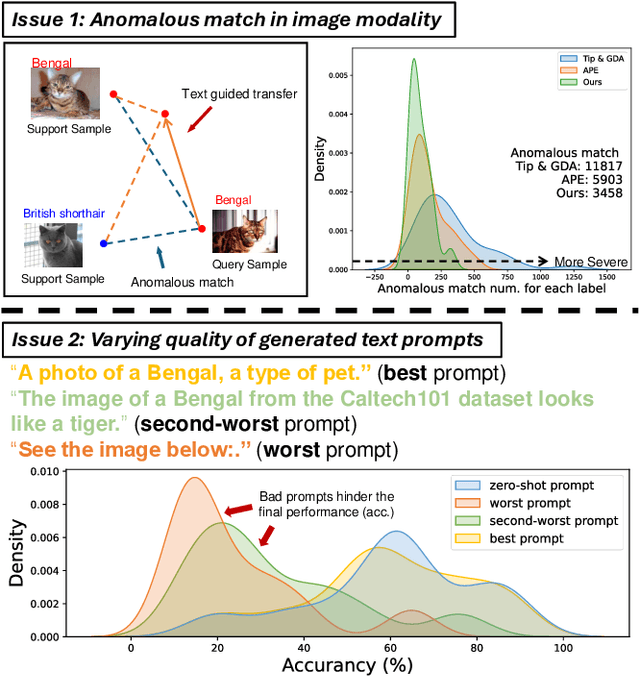
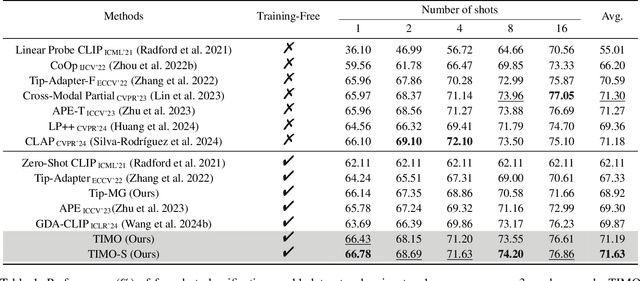
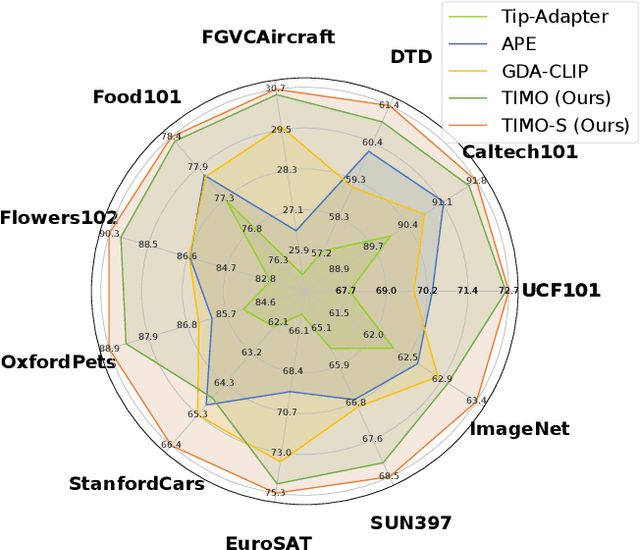

Abstract:Contrastive Language-Image Pretraining (CLIP) has been widely used in vision tasks. Notably, CLIP has demonstrated promising performance in few-shot learning (FSL). However, existing CLIP-based methods in training-free FSL (i.e., without the requirement of additional training) mainly learn different modalities independently, leading to two essential issues: 1) severe anomalous match in image modality; 2) varying quality of generated text prompts. To address these issues, we build a mutual guidance mechanism, that introduces an Image-Guided-Text (IGT) component to rectify varying quality of text prompts through image representations, and a Text-Guided-Image (TGI) component to mitigate the anomalous match of image modality through text representations. By integrating IGT and TGI, we adopt a perspective of Text-Image Mutual guidance Optimization, proposing TIMO. Extensive experiments show that TIMO significantly outperforms the state-of-the-art (SOTA) training-free method. Additionally, by exploring the extent of mutual guidance, we propose an enhanced variant, TIMO-S, which even surpasses the best training-required methods by 0.33% with approximately 100 times less time cost. Our code is available at https://github.com/lyymuwu/TIMO.
Uni-Mlip: Unified Self-supervision for Medical Vision Language Pre-training
Nov 20, 2024Abstract:Recent advancements in vision-language pre-training via contrastive learning have significantly improved performance across computer vision tasks. However, in the medical domain, obtaining multimodal data is often costly and challenging due to privacy, sensitivity, and annotation complexity. To mitigate data scarcity while boosting model performance, we introduce \textbf{Uni-Mlip}, a unified self-supervision framework specifically designed to enhance medical vision-language pre-training. Uni-Mlip seamlessly integrates cross-modality, uni-modality, and fused-modality self-supervision techniques at the data-level and the feature-level. Additionally, Uni-Mlip tailors uni-modal image self-supervision to accommodate the unique characteristics of medical images. Our experiments across datasets of varying scales demonstrate that Uni-Mlip significantly surpasses current state-of-the-art methods in three key downstream tasks: image-text retrieval, image classification, and visual question answering (VQA).
Neural Implicit Representation for Highly Dynamic LiDAR Mapping and Odometry
Sep 26, 2024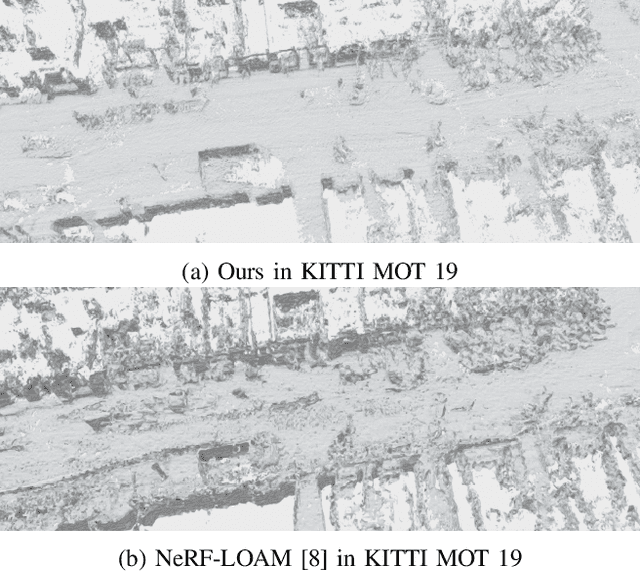



Abstract:Recent advancements in Simultaneous Localization and Mapping (SLAM) have increasingly highlighted the robustness of LiDAR-based techniques. At the same time, Neural Radiance Fields (NeRF) have introduced new possibilities for 3D scene reconstruction, exemplified by SLAM systems. Among these, NeRF-LOAM has shown notable performance in NeRF-based SLAM applications. However, despite its strengths, these systems often encounter difficulties in dynamic outdoor environments due to their inherent static assumptions. To address these limitations, this paper proposes a novel method designed to improve reconstruction in highly dynamic outdoor scenes. Based on NeRF-LOAM, the proposed approach consists of two primary components. First, we separate the scene into static background and dynamic foreground. By identifying and excluding dynamic elements from the mapping process, this segmentation enables the creation of a dense 3D map that accurately represents the static background only. The second component extends the octree structure to support multi-resolution representation. This extension not only enhances reconstruction quality but also aids in the removal of dynamic objects identified by the first module. Additionally, Fourier feature encoding is applied to the sampled points, capturing high-frequency information and leading to more complete reconstruction results. Evaluations on various datasets demonstrate that our method achieves more competitive results compared to current state-of-the-art approaches.
3D Gaussian Splatting: Survey, Technologies, Challenges, and Opportunities
Jul 24, 2024



Abstract:3D Gaussian Splatting (3DGS) has emerged as a prominent technique with the potential to become a mainstream method for 3D representations. It can effectively transform multi-view images into explicit 3D Gaussian representations through efficient training, and achieve real-time rendering of novel views. This survey aims to analyze existing 3DGS-related works from multiple intersecting perspectives, including related tasks, technologies, challenges, and opportunities. The primary objective is to provide newcomers with a rapid understanding of the field and to assist researchers in methodically organizing existing technologies and challenges. Specifically, we delve into the optimization, application, and extension of 3DGS, categorizing them based on their focuses or motivations. Additionally, we summarize and classify nine types of technical modules and corresponding improvements identified in existing works. Based on these analyses, we further examine the common challenges and technologies across various tasks, proposing potential research opportunities.
 Add to Chrome
Add to Chrome Add to Firefox
Add to Firefox Add to Edge
Add to Edge